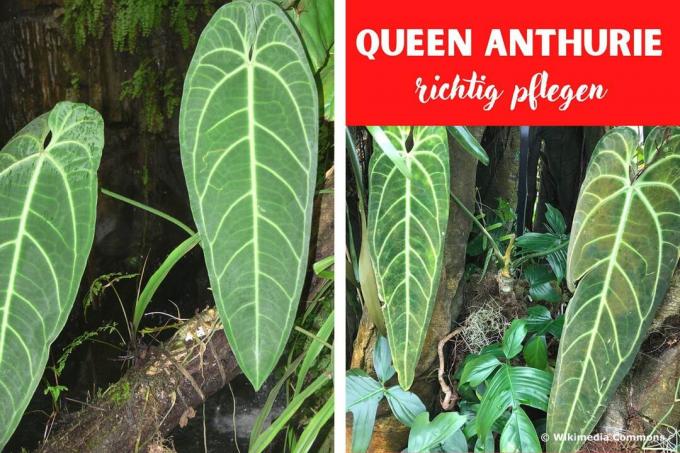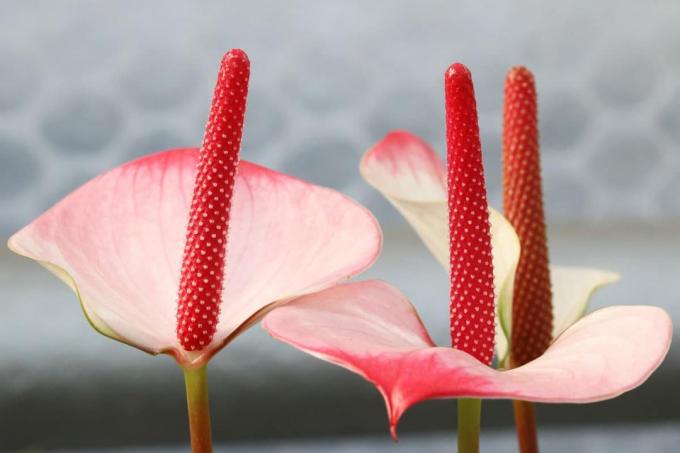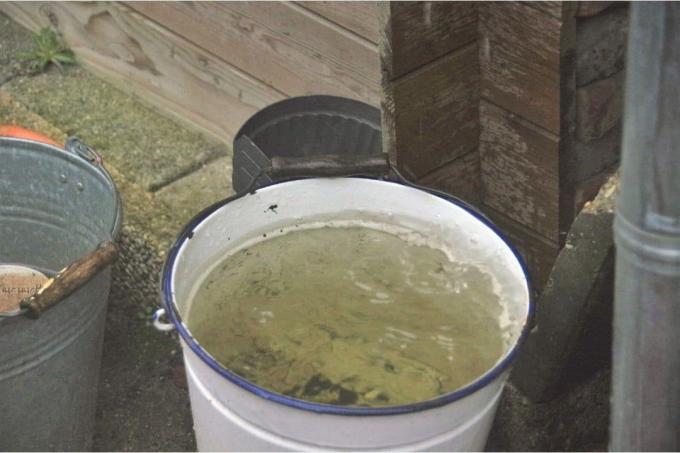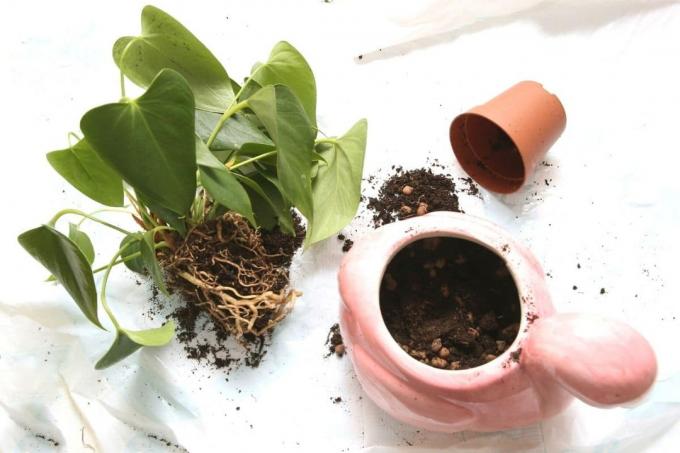
table of contents
- Flowering time and flowering
- Soil condition and location
- Fertilizing and watering
- Diseases and pests
- plants
- Cut
- Overwinter
- Repot
- Multiply
- frequently asked Questions
Profile and care information open +conclude -
- Flower color
- yellow, orange, red
- Location
- Partial shade, no sun
- Heyday
- May June
- Growth habit
- upright
- height
- up to 100 centimeters
- Soil type
- sandy, loamy
- Soil moisture
- moderately dry, moderately moist
- PH value
- weakly sour, sour
- Limescale tolerance
- Calcium intolerant
- humus
- rich in humus
- Poisonous
- Yes
- Plant families
- Arum family, Araceae
- Plant species
- House plants, potted plants
- Garden style
- Pot garden
The Queen Anthurium is a variety from the anthurium genus, which comprises over 1,000 species and is also known in this country as the flamingo flower. Due to its original home in the tropical rainforests of South and Central America, it is mainly cultivated here as a houseplant.
Flowering time and flowering
The flowers of the Anthurium warocqueanum are the long cobs that grow between the colored bracts, which are often mistakenly regarded as flowers. The color of the pistons varies depending on the type between orange, red or yellow. The bracts, on the other hand, shine in a bright red:
- Hybrids bloom in cycles all year round
- when care and posture are right
- for all others between May and June
- after flowering, inconspicuous berries appear

Note: Since the flower bulb does not always grow straight, but can also look out of the bracts when turned, it is often unflatteringly referred to as a "pig's tail".
Soil condition and location
Queen Anthurium is used to warmth and humidity and would like a similar location in the local latitudes. But because the plant originally comes from the rainforests, where there is little sunlight in the lower Areas in which the plant usually grows prevails, it also prefers a place without direct here Exposure to sunlight;
- bright and partially shaded
- East or west windows are well suited
- Temperatures between 20 ° and 25 ° Celsius
- a little cooler in winter
- about 16 ° to 18 ° Celsius
- high humidity is also recommended
- Well-drained, loose and crumbly substrate
- with a high humus content
- acidic or weakly acidic potting soil is well suited
- absolutely avoid lime in the earth
Tip: You should only use lime-free water at room temperature for daily spraying. So that the leaves can better absorb the water from the air, they must also be dusted regularly with a soft, dry cloth.
Fertilizing and watering
Since Anthurium warocqueanum is absolutely lime-intolerant, special attention must be paid to this when watering. Because especially when tap water is used, it is very calcareous depending on the municipality and district. When fertilizing, it is important to ensure that the fertilizer used does not contain any lime:
- use captured rainwater
- alternatively, decalcify tap water
- just letting it stand is not enough here
- only use water at room temperature for watering
- Never let the soil dry out completely
- Waterlogging, on the other hand, must be avoided
- fertilize regularly and frequently
- but always use little fertilizer
- a weekly dose of liquid fertilizer
- from March to September
In winter, you should reduce the nutrient supply to the plant.

Tip: If you don't have a garden to catch the rainwater, you can also place containers on the balcony, in the rain gutter or on the roof under an existing skylight.
Diseases and pests
Diseases and pests always occur on the flamingo flower when something is cared for was done wrong. In some cases, such as insufficient fertilization, they also react by not producing flowers. Especially when the room air is too dry for Queen Anthurium and the leaves are already rolling up, the plant is weakened and scale insects or spider mites can attack it more easily:
- Shower off the plant as a whole
- repeat for several days
- Wipe the leaves with a damp cloth
- so remove the pests
- Increase humidity
- quarantine and separate from other plants
- Pay attention to correct fertilization to strengthen plants
- too much irrigation water leads to waterlogging
- can cause root rot
- recognizable by the increased number of yellow leaves
Even if the location is too cool in both summer and winter, this can damage the Queen Anthurium and cause it to wither.
plants
If a flamingo flower has been purchased commercially, the plant must be planted in a suitable pot. Because it needs both fresh substrate and a little more space. However, the vessel should not be too large. The root ball should have enough space all around in the new pot and not touch the sides. He also needs drainage holes so that the excess water can run off unhindered:
- Place drainage over the drainage hole
- Use pottery shards, balls or gravel
- put plant fleece over this
- Fill in the purchased potting soil halfway
- Remove the root ball from the old pot
- Easily remove soil from roots
- carefully pull them apart
- put in a new container
- fill up the rest of the soil
- water well

Tip: So that the filled soil is well distributed in the bucket, you should carefully hit it several times against a table or on the ground after planting. This is how the earth gets into the spaces between the roots. Then you can fill in another part so that the pot is filled to just below the rim.
Cut
Anthurium warocqueanum does not need pruning. Only if there are yellow leaves should they be removed directly at the base. This is usually done by simply pulling it out, alternatively sharp household scissors that have been cleaned and disinfected beforehand can be used.
Overwinter
So that the Queen Anthurium, which was only grown in the apartment, can be granted a rest phase in winter, it should also be placed cooler in the cold months. A consistently heated room in which there is also dry heating air should therefore be avoided:
- 16 ° to 18 ° Celsius are ideal
- the ideal location is a cool bedroom
- also a bright, unheated staircase
- unheated winter garden
- pour less
- Do not let the soil dry out
- once a month liquid fertilizer with the irrigation water
Anthurium warocqueanum needs this resting phase so that it can continue to sprout again in the next vegetation year and form its decorative bracts with the inner flower.
Repot
The young Anthurium warocqueanum should be repotted every spring so that it can develop into a fully grown specimen over the years. When repotting, proceed as described under “Planting”. At the same time, the flamingo flower can be divided during repotting and in such a case does not need a larger container, just a new substrate. When the plant is fully grown and has reached its final size, a pot with a diameter of 25 centimeters is sufficient:
- Leave the plant in the pot
- only change soil instead of repotting in spring
- remove the top layer of soil here
- fill up new substrate
- Cultivated in hydroponics hardly needs to be repotted

Multiply
During repotting it is possible to multiply Queen Anthurium by dividing, as the root ball is taken from the earth and thus a division can be carried out easily. You should proceed as follows:
- only parts with developed roots
- there should be at least one sheet
- separate by hand
- alternatively use a sharp knife
- plant in a new small pot
- place warm and light
- Put transparent plastic film over it
- this keeps the humidity high
- Don't forget to ventilate regularly
- otherwise mold will form
Tip: Before dividing, you should thoroughly clean and disinfect the cut surface of the tool. Otherwise bacteria, viruses or fungi could get into the new plants via the pieces and damage them.
frequently asked Questions
Various methods can be used to ensure that there is a high level of humidity around the plant. First of all, you should not only water Queen Anthurium at the roots, but also regularly spray the leaves. In addition, bowls filled with water, which you set up close to the plant, often help. Alternatively, you can also use an electric humidifier. A table fountain that is placed next to the flamingo flower is decorative but just as effective.
Hydroponics is particularly suitable for plants like the flamingo flower that want high humidity. Because the water filled in the pot can evaporate better this way. However, you have to pay attention to sufficient fertilization in order to ensure the supply of nutrients
Yes, in all parts of the plant. To prevent skin irritation, you should always wear gloves to prevent skin irritation during maintenance, for example when dusting the leaves. If you have small children or free-roaming or flying pets in the household, you should better refrain from cultivating the decorative plant.
The fully grown flamingo flower can grow to a height of one meter. However, this only works if you repot the plant annually in a new, slightly larger container and this can further spread its roots here.
If Anthurium warocqueanum receives too little light, for example in a north window or in the interior of a room, this quickly leads, as with many other plants, to sparse growth. Here, the new shoots grow very thin and long in search of light, which should be avoided, as it is very damaging to the decorative appearance of the plant.


